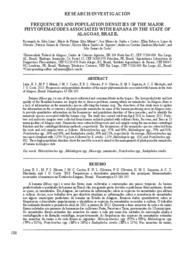Frequencies and population densities of the major phytonematodes associated with banana in the State of Alagoas, Brazil.
Frequencies and population densities of the major phytonematodes associated with banana in the State of Alagoas, Brazil.
Author(s): LIMA, R. da S.; MUNIZ, M. de F. S.; CASTRO, J. M. da C. e; OLIVEIRA, E. R. L. de; OLIVEIRA, P. G. de; SIQUEIRA, K. M. S. de; MACHADO, A. C. Z.; COSTA, J. G. da
Summary: Banana (Musa spp.) is one of the most cultivated and consumed fruits in the tropics. The low productivity and low quality of the Brazilian bananas are largely due to disease problems, among which are nematodes. In Alagoas, there is a lack of information on the nematodes species affecting the banana crop. The objectives of this study were to update the information on the occurrence of plant-parasitic nematodes in some of the banana producing areas in Alagoas state, to provide quantitative information on the frequencies and population densities of these parasites, and to identify the nematode species associated with the banana crop. The study was carried out from April 2011 to January 2012. Fortytwo soil and roots samples were collected from banana orchards planted with cultivars Prata, Pacovan, and Terra in 13 municipalities of Alagoas state. Nematodes were extracted from roots and soil samples using the maceration-centrifugal flotation and the centrifugal-flotation methods, respectively. The frequencies of the nematodes species extracted from the roots and soil samples were as follows: Helicotylenchus spp., 95% and 98%; Meloidogyne spp., 79% and 81%; Pratylenchus spp., 36% and 26%; and Radopholus similis, 38% and 21%; respectively. On average, Helicotylenchus spp. was most abundant with 2,359/ 50 g root, followed by R. similis: 1,359, Meloidogyne spp.: 810, and Pratylenchus spp.: 682. These high population densities show the need for research aimed at the management of plant-parasitic nematodes of banana in Alagoas state.
Publication year: 2013
Types of publication: Journal article
Unit: Embrapa Semi-arid Region
Keywords: Banana, Disease, Doença, Fitonematoide, Helicotylenchus, Meloidogyne, Musa, Musa spp, Nematoide, Pratylenchus, Radopholus Similis
Observation
Some of Embrapa's publications are published as ePub files. To read them, use or download one of the following free software options to your computer or mobile device. Android: Google Play Books; IOS: iBooks; Windows and Linux: Calibre.
Access other publications
Access the Agricultural Research Database (BDPA) to consult Embrapa's full library collection and records.
Visit Embrapa Bookstore to purchase books and other publications sold by Embrapa.

